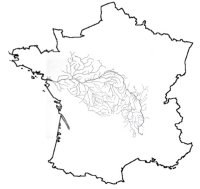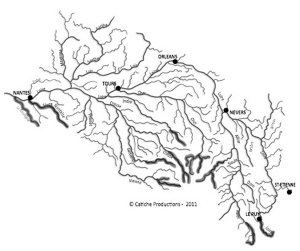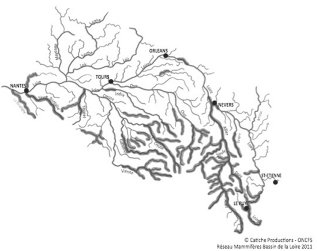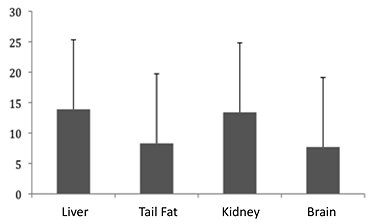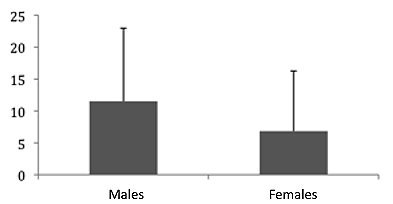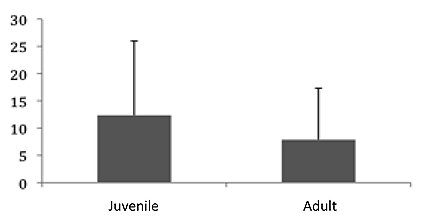IUCN/SSC Otter Specialist Group Bulletin

|
©IUCN/SCC Otter Specialist Group Citation: Lemarchand, C., Rosoux, R. and Berny, P. (2011) Ecotoxicology of the Eurasian Otter (Lutra lutra) along Loire River (France) and Predictable Trends due to Global Change. Proceedings of XIth International Otter Colloquium, IUCN Otter Spec. Group Bull. 28B: 5 - 14 Ecotoxicology of the Eurasian Otter (Lutra lutra) along Loire River (France) and Predictable Trends due to Global Change Charles Lemarchand1, Rene Rosoux2 and Philippe Berny 1
1VetAgro Sup Campus Vétérinaire de Lyon,
1 Avenue Bourgelat, F-69280 Marcy l'Étoile, France
|


 |
| (received 14th October 2011, accepted 31st October 2011) |
|
Abstract: In this study, about fifty otters from the basin of the Loire River (France) were analyzed in the context of a toxicological study funded by the Plan Loire Grandeur Nature. Individuals were recovered non-invasively, using a network of collection of otters killed by traffic collisions with vehicles. The chemical elements analyzed were the organochlorine and organophosphorus pesticides, carbamates, pyrethroids, herbicides, anticoagulants, PCBs and metals. Detectable levels of organochlorine pesticides and PCBs characterized all otters analyzed, with mean values reaching 2-15 mg kg-1, respectively. Concentrations of other analyzed pesticides remained very low. For metals, contamination of otters was systematic for lead and mercury, the latter being relatively abundant in tissues of several individuals. A significant trend to increasing concentrations of pesticides and PCBs by going towards the downstream parts of basins was shown. The inter-individual variations in concentrations were marked. Global values of contamination were below the toxicological threshold defined for the conservation of the species, and the current dynamics of populations within the basin of the Loire seems to confirm this. However, the potential effects of mixtures of compounds remain poorly studied. |
| Keywords: Eurasian otter; Loire River; pesticides; PCBs; metals |
| Française | Español |
INTRODUCTION
An important dynamic of scientific works is running on the Loire River, which is considered one of the last wild rivers in Europe, because of its large size, its large proportion of natural habitats and its important community of wild fauna or flora in a good state of conservation. Flagship species like Atlantic salmon (Salmo salar), osprey (Pandion haliaetus), white-clawed crayfish (Austropotamobius pallipes), pearl mussel (Margaritifera margaritifera) and Eurasian otter (Lutra lutra) inhabit and naturally reproduce along the Loire River or tributaries, in preserved habitats (Bouchardy, 2002). But as with most of the aquatic environments in Europe, the Loire River suffers from increases in human population and associated water demand, for domestic use or crop irrigation, from physical alterations and contamination of food webs by toxic compounds, and from potential consequences of global change; a recent study using models (Moatar et al., 2010) stated three major previsions: increase of global water temperature at the hydrosystem scale, strong alterations in seasonal fluvial dynamic, and potential strong modifications of species diversity or abundance, where sensitive species appeared to be the most threatened. In order to study and protect the Loire river catchment and environment during human activities development and global change, «Plan Loire Grandeur Nature» (www.plan-loire.fr) was launched in 1994, and is still running today, until 2013.
The Eurasian otter (Lutra lutra), formerly widespread in Europe has strongly declined during the 20th century, following direct persecutions, habitat alteration and pollution, and consecutively decline of main prey (Bouchardy, 1986; Bouchardy et al., 2001; Lemarchand and Bouchardy 2011). Direct persecutions were perpetrated as otters were considered an active competitor to fishing activity. After direct destructions, intoxication by persistent pollutants (e.g. pesticides, PCBs or heavy metals) is blamed as the causative agent of the populations’ decline throughout Europe. Indeed, these compounds were shown to accumulate in otters, causing body condition alteration, direct reproductive failure and consecutively population decline (Mason and Macdonald, 1993a,b; Ruiz-Olmo et al., 2000; Garshelis and Johnson, 2001; Fournier-Chambrillon et al., 2004). Due to environmental stability and persistence of compounds, and probably following post-ban use of old stocks, metals, pesticides and PCBs still accumulate in the environment and were recently detected in otters (Kannan et al., 2004; Lemarchand et al., 2007, 2010; 2011a). The majority of total organochlorine contamination is generally represented by PCBs, organochlorine pesticide levels being lower and decreasing (Mason and Macdonald, 1993a,b; Lemarchand et al., 2010). Other classes of pesticides like cholinesterase inhibitors such as organophosphate (OP) and carbamate (CA), pyrethroids insecticides, herbicides and fungicides were poorly reported in literature concerning otters. However, they were shown to accumulate and affect fish, amphibians, mammals, insectivorous birds, birds of prey and scavengers like the white-tailed sea eagle (Haliaetus albicilla) or red kite (Milvus milvus) (Santillo et al., 1989; Hart et al., 1993; Elliot et al., 1996; Martin et al., 1998; Chu et al., 2005; Berny and Gaillet, 2008; Langlois et al., 2009; Tillitt et al., 2010). Otter populations should therefore be directly affected by acute or chronic poisoning or by depletion in food supply. Nevertheless, after approximately three decades of protection and habitat restoration, the otter population in France is naturally increasing. Mixing of formerly isolated populations, from the beginning of the 2000’s, saw the repartition area of the species increase to cover the whole Massif Central related to the western third of the country (Kuhn, 2009; Lemarchand and Bouchardy, 2011). Increase of otter populations particularly concerns the Loire River catchment, a major dispersal corridor that should be decisive for species conservation and dispersion in the whole country.
The objectives of this study were to evaluate the contamination of Eurasian otter by a wide spectrum of pesticides, using a non-invasive approach during a natural recolonization process in the Loire River catchment. Forty-five pesticides, including herbicides, organochlorine, organophosphate, carbamate and pyrethroids pesticides were systematically analyzed in otters (but also in ospreys, great cormorants, freshwater fish and invertebrates) from the Loire River catchment (Lemarchand et al. 2007, 2009, 2010, 2011a,b).
ANIMALS, MATERIALS AND METHODS
Dead otters, retrieved from road-traffic accidents were collected and stored at -40° C since 2004 for necropsies, biometrical, genetical, dietary and ecotoxicological studies under the coordination of the Muséum d’Orléans and VetAgro Sup. A convention with the French Office for Hunting and Wildlife (ONCFS) allowed rapid and legal collection of otters. European community (FEDER Loire), “Plan Loire Grandeur Nature”, “Etablissement Public Loire” and VetAgro Sup funded this toxicological program. More than 200 otters were collected and analysed, and data were complemented by analyses of otter spraints from different parts of the catchment. Otter carcasses were necropsied according standard protocols (Simpson et al., 2000), and samples of liver, muscle, kidney, brain, tail and peritoneal fat were used for contaminants analyses. Fur and stomach/intestine were stored for genetics and diet/digestives parasites, respectively. Contamination of otters by organochlorine pesticides, herbicides, PCBs, heavy metals and metalloids (mercury, lead, cadmium, copper and arsenic) and anticoagulant rodenticides (including bromadiolone and chlorophacinone) was studied by gas/liquid chromatography or atomic absorption spectrometry. All analytical protocols have been described (Lemarchand et al., 2007, 2010, 2011a).
RESULTS AND DISCUSSION
Results presented hereafter are preliminary, as a lot of analyses are still running at the time of this publication: about 50 otters coming from the Allier River (major tributary of Loire River fully occupied by otters) were analyzed for organochlorine, organophosphate, herbicides and pyrethroids pesticides, PCBs and metals.
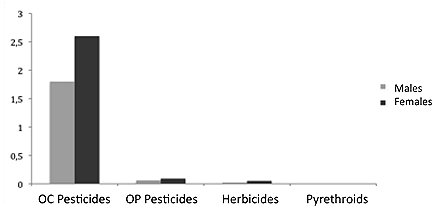 |
|
| Figure 2.
Contamination of 50 otter livers from Allier River by pesticides (mg.kg-1 of fresh weight) Click for larger images |
Contamination of otters (expressed as mg kg-1 of compounds in fresh liver) is represented in Figure 2. It can be observed that total OC pesticides, and particularly lindane and DDTs (specific data not shown) are the most abundant toxic compounds in tissues. Another point is that OC pesticides contaminated 100% of the otters. None of the otters examined were found to be entirely free from toxic contaminants. Concerning other pesticide classes, organophosphate (OP) pesticides were very rare, only detected in a few otters, and at low concentrations. Herbicides and pyrethroids were almost never detected. These results underline the persistence of some OC pesticides within the environment and their affect on otters (Roos et al., 2001), long after a legal ban (1973 for DDT in France). We observed significant differences between males and females for OC contamination, females being more contaminated. Differences with sex for the other compounds and differences with age for all compounds were not significant. A significant increase in total contamination of otter tissues by pesticides was noted by going downstream of the catchment. This result was also observed concerning otter spraints from the same population (Lemarchand et al., 2007) and corresponds to environmental levels (IFEN, 2006). As this is also the global way used by the species during the natural recolonization process (according to field studies reported in Lemarchand and Bouchardy 2011), it can be supposed a toxicological impact of total pesticides contamination on otter’s population dynamic on a long-term period.
Results concerning contamination of the same 50 otters by PCBs are shown on Figures 3 to 5. Data were expressed as a function of main tissues, sex or age class of otters.
By looking at the results concerning PCB contamination of the same otter livers, it can be underlined that all otters, without exception, were contaminated with PCBs, concentrations ranged from 8 to approximately 15 mg per kg of fresh weight. Interindividual variations were very high, suggesting some heavy contamination cases. Approaching values were observed in other studies on otters in Europe, without heavy consequences on population dynamic (Kruuk and Conroy 1996; Roos et al., 2001; Colas et al., 2005; Lemarchand et al., 2010). Concentrations were not significantly different between sexes, but we observed a quite high contamination of young individuals. A transfer of PCBs from lactating females to young could be suggested as a hypothesis, but PCBs did not seem to linearly accumulate with age (Kruuk, 2006). We observed a significant increase of total PCBs concentrations in otter tissues by going downstream of river catchment, as observed for organochlorine pesticides. This pattern seems logical, as it increases with human population. As otters also use this downstream way during recolonization (Lemarchand and Bouchardy, 2011), it could be supposed a potential toxicological impact of total PCBs contamination on species’ dynamic on a long-term period. Nevertheless the observed values of total PCBs, especially concerning females, remained lower than critical thresholds of effects on reproduction, as underlined by Christensen et al. (2010).
Otter contamination by metals during this study is shown on Figure 6. Data are expressed as mg.kg-1 of dry liver.
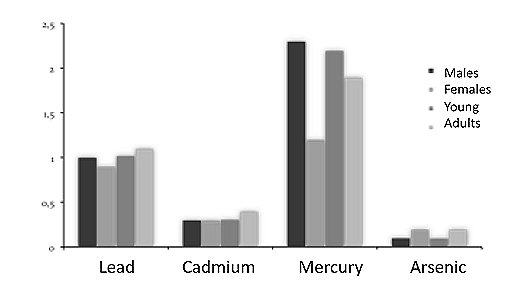 |
|
| Figure 6.
Contamination of otters from Allier River catchment by metals (mg.kg-1 of fresh weight) Click for larger images |
As underlined for organochlorine pesticides and PCBs, the four metals were detected in all otters examined; mercury concentrations were the highest, lead to a lesser extent. Cadmium and arsenic concentrations were low and are not supposed to constitute a threat for otters. Mercury concentrations observed here (up to 2,3 mg mg-1 in livers of adult males) were higher than those observed in other studies elsewhere (Gutleb et al., 1998; Ruiz-Olmo et al., 2000; Colas et al., 2005; Lanszki et al., 2009). Such concentrations can be explained by a high contamination of Allier River during ancient industrial activities. The highest value of mercury in liver of an otter (19,7 mg mg-1dw, data not shown), associated with high inte-rindividual variations suggested strong intoxication at individual scale. Nevertheless mean mercury concentration of the total sample remained in the background for otters (Gutleb et al. 1998, Lanszki et al. 2009). Differences with sex and age were not significant concerning metals. Figures 7 and 8 present concentrations of mercury and lead in livers of otters from different administrative regions of France, located along the Loire River catchment.
 |
|
| Figure 7.
Concentrations of mercury in otters coming from different administrative regions of Loire River catchment in France (mg.kg-1 of fresh weight) Click for larger images |
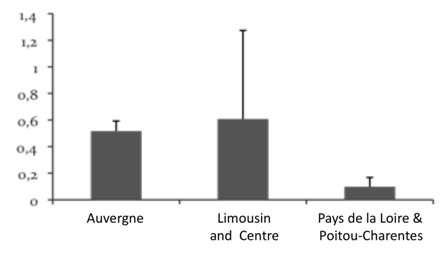 |
|
| Figure 8.
Concentrations of lead in otters coming from different administrative regions of Loire River catchment in France (mg.kg-1 of fresh weight) Click for larger images |
To the whole catchment level, considering results observed in different regions of France (Auvergne, Limousin, Centre and Poitou-Charentes), measured values underline high interindividual contamination, with important differences between areas. Otters from higher parts of Loire River catchment were more contaminated by mercury and lead than those from lower parts of the catchment. This is also true concerning organochlorine pesticides and PCBs (data not shown) and was noted in previous studies (Kruuk et al., 1997; Lemarchand et al., 2007; Mazet et al., 2005; Boscher et al. 2010). As these upper parts are sources of individuals for the recolonization process, the question of total contamination impact on population dynamic can be underlined.
Furthermore, contamination cases by anticoagulant rodenticides (only by bromadiolone) were also observed, without recorded mortality. Fournier-Chambrillon et al. (2004) observed mortality cases in France on aquatic and riparian mustelids (Eurasian otter and European mink Mustela lutreola). This underlines the secondary risk of poisoning of protected species by using non-selective control methods of rodents.
CONCLUSION
Results of a systematic analysis of otters killed in road-traffic accidents collected along the Loire River indicate widespread contamination, especially concerning PCBs, mercury, lead and organochlorine pesticides. Secondary poisoning by anticoagulant rodenticides was confirmed. Important differences were noted, between individuals and between geographic areas, with significant accumulation of some compounds by going downstream in the upper part of the catchment. Considering the present growth of the population, toxic contamination is not supposed to constitute a major threat to short-term otter conservation. Nevertheless, biomagnification in food chain and higher downstream concentrations of toxic compounds are able to disrupt biological corridors of recolonization by direct intoxication or depletion in food supply. Furthermore, there is very few information on potential effects of the synergistic effects of the studied compounds in a mid- or long-term perspective.
ACKNOWLEDGMENTS - Authors wish to thank D. Vey and the technical team of the VetAgro Sup Toxicology unit, the French ONCFS and ONEMA services, Ph. Guillet, M.-F. Larigauderie and the Museum of the City of Orléans, M.-d.-N. De Bellefroid, and environmental associations for providing otters or information. This study was financially supported by: European Commission (FEDER), “Loire Grandeur Nature” program, Etablissement Public Loire, Parc naturel régional des Volcans d’Auvergne, Agence de l’Eau Loire-Bretagne, ENVL and CNRS.
REFERENCES
Berny, P., Gaillet, J.-R. (2008). Acute poisoning of red kites (Milvus milvus) in France: data from the SAGIR network. J. Wildl. Dis. 44: 417-426.
Bouchardy, C. (1986). La loutre. Sang de la Terre, 186p.
Bouchardy, C., Boulade, Y., Rosoux, R., Gouilloux, N. (2001). La loutre d’Europe, histoire d’une sauvagarde. Catiche productions – Libris, 32p.
Bouchardy, C. (coord.) (2002). La Loire. Vallée et vals du grand fleuve sauvage. Delachaux et Nieslté, Lonay – Paris, 288p.
Boscher, A., Gobert, S., Guignard, C., Ziebel, J., L’Hoste, L., Gutleb, A.C., Cauchie, H.-M., Hoffmann, L., Schmidt, G. (2010). Chemical contaminants in fish species from rivers in the North of Luxembourg: Potential impact on the Eurasian otter (Lutra lutra). Chemosphere 78: 785-792.
Christensen, H. Heggberget, T. M., Gutleb, A.C. (2010). Polychlorinated biphenyls and reproductive performance in otters from the norwegian coast. Arch Environ Contam Toxicol 59:652–660.
Chu, S., Henny, C.J., Kaiser, J.L., Drouillard, K.G., Haffner, G.D., Letcher, R.J. (2007). Dacthal and chlorophenoxy herbicides and chlorothalonil fungicide in eggs of osprey (Pandion haliaetus) from the Duwamish-Lake Washington-Puget Sound area of Washington State, USA. Environ Pollut. 145: 374-381.
Colas, C, Caurant, F., Rosoux, R., De Bellefroid, M.D.N. (2006). Recherche de contaminants organiques et métalliques chez la loutre d’Europe (Lutra lutra) dans l’ouest de la France. Rapport de synthèse, plan de restauration national. Université de La Rochelle - UMR 6217 CNRS, Université de Bordeaux I – UMR 5472 CNRS, MEDD, DIREN Poitou-Charentes, Région Poitou-Charentes, Ville de La Rochelle.
Elliott, J.E., Langelier, K.M., Mineau, P., Wilson, L.K. (1996). Poisoning of bald eagles and red-tailed hawks by carbofuran and fensulfothion in the Fraser delta of British Columbia. J. Wildl. Dis. 32: 486-491.
Fournier-Chambrillon, C., Berny, P., Coiffer, O., Barbedienne, P., Dasse, B., Delas, G., Galineau, H., Mazet, A., Pouzenc, P., Rosoux, R., Fournier, P. (2004). Evidence of secondary poisoning of free-ranging riparian mustelids by anticoagulant rodenticides in France: implications for conservation of European mink (Mustela lutreola). J. Wild. Dis. 40: 688-695.
Garshelis, D.L., Johnson, C.B. (2001). Sea otter population dynamics and the Exxon Valdez oil spill: disentangling the confounding effects. J. Appl. Ecol. 38: 19-35.
Gutleb, A.C., Kranz, A., Nechay, G., Toman, A. (1998). Heavy metal concentration in livers and kidneys of the otter (Lutra lutra) from central Europe. Bull. Environ. Contam. Toxicol. 60: 273-279.
Hart, A.D.M. (1993). Relationships between behavior and the inhibition of acetylcholinesterase in birds exposed to organophosphorus pesticides. Environ. Toxicol. Chem. 12: 321-336.
IFEN (2006). L’environnement en France. Edition 2006. Institut français de l’environnement, 507p.
Kannan, K., Kajiwara, N., Watanabe, M., Nakata, H., Thomas, N.J., Stephenson, M., Jessup, D., Tanabe, S. (2004). Profiles of polychlorinated biphenyl congeners, organochlorine pesticides, and butyltins in southern sea otters and their prey. Environ. Toxicol. Chem. 23: 49-56.
Kruuk, H. (2006). Otters. Ecology, behaviour and conservation. Oxford University Press, Oxford, 265p.
Kruuk, H., Conroy, J.W.H. (1996). Concentrations of some organochlorine on otters (Lutra lutra) in Scotland: implications for populations. Environ. Pollut. 92: 165-171.
Kruuk, H., Conroy, J.W.H., Webb, A. (1997). Concentrations of mercury in Otters (Lutra lutra L.) in Scotland in relation to rainfall. Environ. Pollut. 96: 13-18.
Kuhn, R. (2009). Plan National d’Actions pour la Loutre d’Europe (Lutra lutra), 2010-2015. Société Française pour l’Etude et la Protection des Mammifères/Ministère de l’Ecologie, de l’Energie, du Développement Durable et de la Mer.
Langlois, V.S., Carew, A.C., Pauli, B.D., Wade, M.G., Cooke, G.M., Trudeau, V.L. (2010). Low levels of the herbicide Atrazine alter sex ratios and reduce metamorphic success in Rana pipiens tadpoles raised in outdoor mesocosms. Environ. Health Persp. 118: 552-557.
Lanszki, J., Orosz, E., Sugár, L. (2009). Metal levels in tissues of Eurasian otters (Lutra lutra) from Hungary: variation with sex, age, condition and location. Chemosphere 74: 741-743.
Lemarchand, C., Amblard, C., Souchon, Y., Berny, P. (2007). Organochlorine compounds (pesticides and PCBs) in scats of the European otter (Lutra lutra) from an actual expanding population in central France. Water, Air Soil Pollution 186: 55-62.
Lemarchand, C., Bouchardy, C. (2011). La loutre d’Europe, histoire d’une sauvegarde. Catiche Productions, 32p.
Lemarchand, C., Rosoux, R., Berny, P. (2009). Etude toxicologique du basin de la Loire à l’aide de bioindicateurs, dans le contexte des effets prévisibles du réchauffement climatique. Plate-Forme Recherche/Données/Informations, Plan Loire Grandeur Nature 2007-2013, www.plan-loire.fr.
Lemarchand, C., Rosoux, R., Berny, P. (2010). Organochlorine pesticides, PCBs, heavy metals and anticoagulant rodenticides in tissues of Eurasian otters (Lutra lutra) from upper Loire River catchment (France). Chemosphere 80: 1120-1124.
Lemarchand, C., Rosoux, R., Berny, P. (2011a). Semi aquatic top-predators as sentinels of diversity and dynamics of pesticides in aquatic food webs. The case of European otter (Lutra lutra) and Osprey (Pandion haliaetus) in Loire River catchment, France. In: Stoytcheva, M. (ed.), Pesticides in the Modern World: Risks and benefits. InTech, ISBN 978-953-307-458-0. http://www.intechopen.com/articles/show/title/semi-aquatic-top-predators-as-sentinels-of-diversity-and-dynamics-of-pesticides-in-aquatic-food-webs
Lemarchand, C., Rosoux, R., Pénide, M.-E., Berny, P. (2011b).Tissue concentrations of pesticides, PCBs and metals among ospreys, (Pandion haliaetus), collected in France" Bulletin of Environmental Contamination and Toxicology (to be published).
Martin, P.A., Johnson, D.L., Forsyth, D.J., Hill, B.D. (1998). Indirect effects of the pyrethroid insecticide deltamethrin on reproductive success of chestnut-collared longspurs. Ecotoxicology 7: 87-97.
Mason, C.F., Macdonald, S.M. (1993a). Impacts of organochlorine pesticide residues and PCBs on otters (Lutra lutra): a study from western Britain. Sci. Total Environ. 138: 127-145.
Mason, C.F., Macdonald, S.M. (1993b). Impacts of organochlorine pesticide residues and PCBs on otters (Lutra lutra) in eastern Britain. Sci. Total Environ. 138: 147-160.
Mazet, A., Keck, G., Berny, P. (2005). Concentrations of PCBs, organochlorine pesticides and heavy metals (lead, cadmium, and copper) in fish from the Drôme River: potential effects on otters (Lutra lutra). Chemosphere 61: 810-816.
Moatar, F. (2010). Impact du changement climatique sur l’hydrosystème Loire: HYDROlogie, régime thermique, QUALite. Plate-Forme Recherche / Données / Informations, Plan Loire grandeur Nature (www.plan-loire.fr).
Roos, A., Greyerz, E., Olson, M., Sandegren, F. (2001). The otter (Lutra lutra) in Sweden - population trends and relation to SDDT and total PCB concentrations during 1968-99. Environ. Pollut. 111: 457-469.
Ruiz-Olmo, J., Lafontaine, L., Prigioni, C., Lopez-Martin, J.M., Santos-Reis, M. (2000). Pollution and its effects on otter population in south-western Europe. In: Proceedings of the First Otter Toxicological Conference. Edited by Conroy, J.W.H., Yoxon, P. & Gutleb, A.C. Isle of Skye, September 2000, 186p.
Santillo, D., Leslie, D., Brown, P. (1989). Responses of small mammais and habitat to glyphosate application on clearcuts. J Wildl Manage. 53: 164-172.
Simpson, V.R. (2000). Diseases of Otters in Britain. In: Proceedings of the First Otter Toxicological Conference. Conroy, J.W.H., Yoxon, P., Gutleb, A.C. (eds.) Isle of Skye, September 2000, 186pp.
Tillitt, D.E., Papoulias, D.M., Whyte, J.J., Richter, C.A. (2010). Atrazine reduces reproduction in fathead minnow (Pimephales promelas). Aquatic Toxicology 99: 149-159.
Résumé : Étude Ecotoxicologique de la Loutre d’Europe dans le Bassin de la Loire (France) et Tendances Previsibles Liées aux Changements Climatiques
Dans cette étude, une cinquantaine de loutres provenant du bassin du fleuve Loire (France) ont été analysées, dans le cadre d’une étude toxicologique financée par le Plan Loire Grandeur Nature. Les individus ont été récupérés de manière non invasive, en utilisant un réseau de collecte des loutres tuées par des collisions routières avec des véhicules. Les éléments chimiques recherchés ont été les pesticides organochlorés et organophosphorés, les carbamates, les pyréthrines, les herbicides, les anticoagulants, les PCBs et les métaux. L’ensemble des loutres analysées s’est caractérisé par des taux détectables de pesticides organochlorés et de PCBs, avec des valeurs moyennes non négligeables atteignant 2 à 15 mg.kg-1, respectivement. Les concentrations des autres pesticides analysées sont restées très faibles. Concernant les métaux, la contamination des loutres s’est avérée systématique pour le plomb et le mercure, ce dernier élément étant relativement abondant dans les tissus de plusieurs individus. Une tendance significative à l’augmentation des concentrations de pesticides et de PCBs en se dirigeant vers les parties aval des bassins a été montrée. Les variations inter-individuelles des concentrations se sont révélées importantes. Les valeurs globales de contamination sont inférieures aux seuils toxicologiques définis pour la conservation de l’espèce, et la dynamique actuelle des populations au sein du bassin de la Loire semble le confirmer. Néanmoins, les effets potentiels des mélanges de composés demeurent mal connus et doivent être suivis dans les études futures.
Revenez au dessus
Resumen: Ecotoxicología de la Nutria Europea (Lutra lutra) a lo Largo del Río Loire (Francia), y Tendencias Predecibles Debido al Cambio Global
En este estudio, analizamos alrededor de cincuenta nutrias de la cuenca del Río Loire (Francia), en el contexto de un estudio toxicológico costeado por el Plan Loire Grandeur Nature. Los individuos fueron recuperados de manera no-invasiva, utilizando una red de colección de nutrias muertas por colisiones con vehículos. Los elementos químicos analizados fueron los pesticidas organoclorados y organofosforados, carbamatos, piretroides, herbicidas, anticoagulantes, PCBs y metales. Todas las nutrias se caracterizaron por tener niveles detectables de pesticidas organoclorados y PCBs, con valores medios que alcanzaron 2-15 mg/kg, respectivamente. Las concentraciones de los otros pesticidas analizados fueron muy bajas. Para los metales, la contaminación de las nutrias fue sistemática para plomo y mercurio, siendo el último relativamente abundante en tejidos de varios individuos. Quedó evidenciada una tendencia significativa de incremento de las concentraciones de pesticidas y PCBs a medida que se desciende a las partes de corriente-abajo de las cuencas. Las variaciones inter-individuales en las concentraciones fueron marcadas. Los valores globales de contaminación estuvieron por debajo del umbral toxicológico definido para la conservación de la especie, y la actual dinámica de las poblaciones de la cuenca del Loire parece confirmarlo. Sin embargo, los efectos potenciales de las mezclas de compuestos aún están pobremente estudiados.
Vuelva a la tapa
